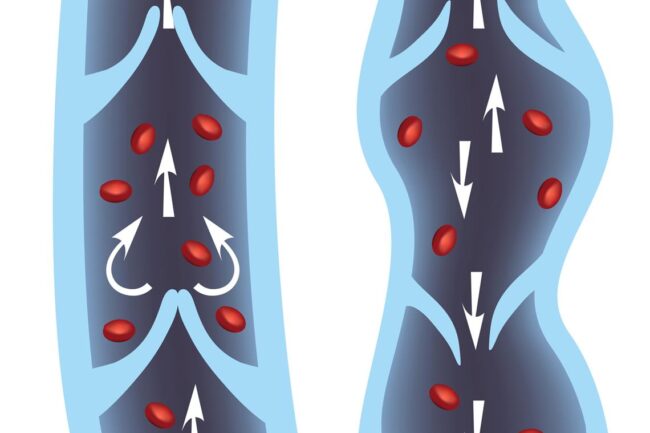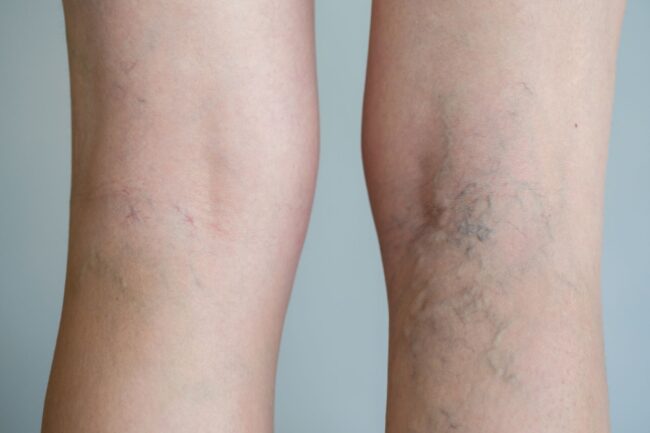Why do veins have valves? Why are veins so blue? Why are vein walls so thin? Everyone has veins, but not many know how they work. So as vascular specialists, we wanted to answer commonly asked vein questions to give you a better understanding of your vascular system and help you make informed decisions about your vein health.
Why do veins have valves?
Veins have valves to stop blood from flowing backwards. Your arteries don’t need much help moving blood around, as they’re well-supported by the powerful beats of your heart (and in most of your body, don’t need to fight against gravity). Your veins, however, rely on surrounding muscles to move blood up to your heart and on tiny, one-way valves to keep it flowing in the desired direction.
If the valves malfunction, blood will pool in the vein instead of travelling where it needs to be. And over time, this may lead to bulging varicose veins.

Illustration of two veins side-by-side. The one on the left is healthy, with straight vein walls and working valves. The one on the right is unhealthy, with curved walls and valves not closing all the way and letting blood reflux
Why do veins collapse?
Veins typically collapse due to a vein wall injury, which can force the walls to swell up and stick together, preventing blood from coming through. Repeated injections (such as with intravenous drug use) or even just an improper blood draw technique can prompt a vein to collapse.
Additionally, veins may collapse as a result of a medical procedure. Injecting sclerosant into the vein to address varicose or spider veins irritates the vein walls, causing them to swell shut. Of course, in this case, it’s better if the collapse is permanent – which we ensure through 2-3 injections. With no blood moving through the vein, the body can absorb it, making your spider or varicose vein disappear over time.
Learn more about varicose vein treatment: Non-surgical Varicose Veins Treatment
Why do veins look blue?
Veins look blue because of the way wavelengths of light hit the skin. Red light has a much easier time penetrating our skin layers, while colder light tones like blues, greens, and purples scatter back toward our retinas. So while veins always carry rich, red, deoxygenated blood (at least in most mammals), the vessels appear blue.
Learn more: Here’s The Reason Behind Your Blue Veins
Why do veins have thin walls?
Veins are subject to lower blood pressure than arteries, so their walls don’t need to be as thick. The downside of that is that veins are a bit more fragile. Especially if they’re enlarged due to a vein disorder like varicose veins, they’ll be more prone to bursting underneath the skin or bleeding when cut.
Learn more: Bleeding Varicose Veins: Here’s What to Do
Why do veins stick out?
Veins can appear to pop out, bulge, or otherwise protrude above the skin surface for several reasons.
- Strenuous exercise. When you’re weightlifting, sprinting, or playing an intense sport, your muscles demand a lot more oxygen. And while your arteries won’t have trouble delivering it, the veins will have difficulty keeping up. Hence, blood volume in the veins increases, causing them to temporarily appear bulkier.
- Anatomy. Some veins may simply run a little closer to the skin’s surface than others. Additionally, you may have inherited thinner skin, making your veins appear more prominent. Veins also stand out more if you have a lower amount of fat. For example, compare a bodybuilder’s veins to the average person’s. Or the veins in your hands and feet to those in your upper legs.
- Age. As we age, our skin tends to get even thinner, making veins stick out.
- Temperature. Heat prompts veins to dilate and run closer to the skin surface to cool you off. This process can make them look more prominent.
But, while some cases of prominent veins are perfectly normal, others may be a cause for concern. If your bulging veins are twisted in appearance and accompanied by symptoms like itching, swelling, aches, and limb fatigue, you may have varicose veins.
Learn more: Who’s more likely to get varicose veins: the 7 risk factors
Seek specialist advice
The most important thing to remember about veins is to seek specialist advice if something feels off. A bulging, twisted appearance, pains, heaviness in the affected limb, and skin changes can indicate an underlying disorder. The sooner it’s caught, the better – both for your health and quality of life.
At The Vein Institute, we specialise in treating varicose leg veins through minimally invasive procedures. So if you have bulging, painful veins, don’t hesitate to get in touch. Call us on 0420 102 637 or request an appointment online.
See more facts about veins: Answering Your Vein FAQs


